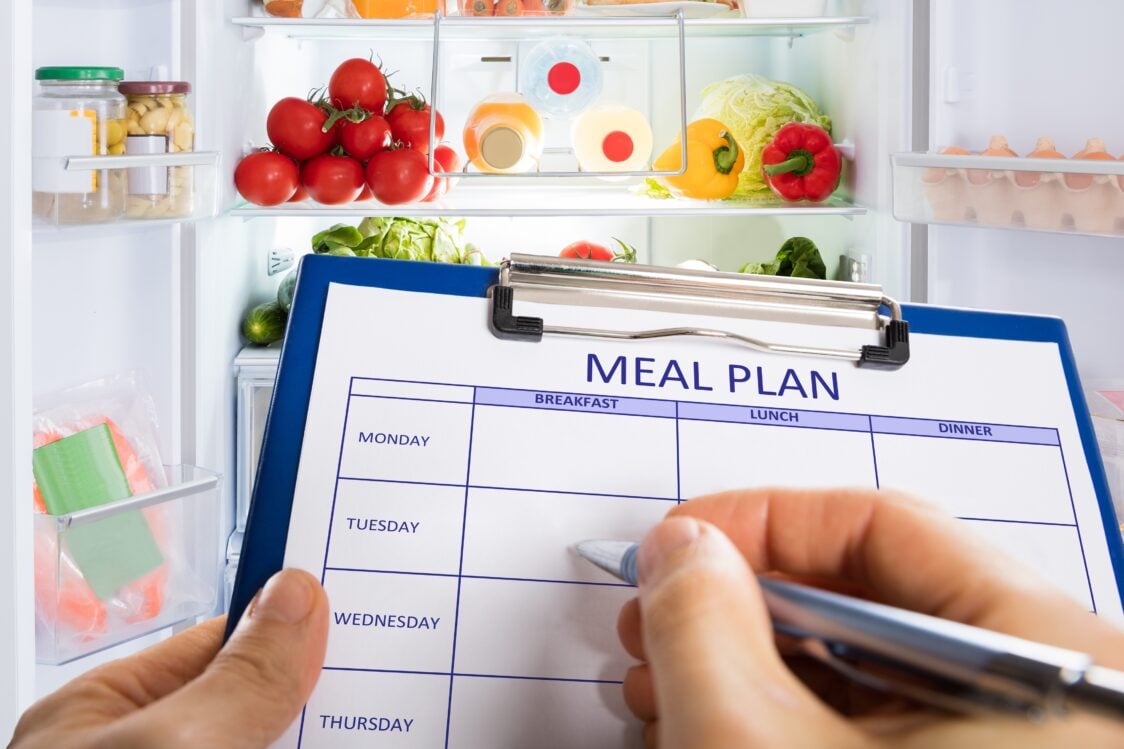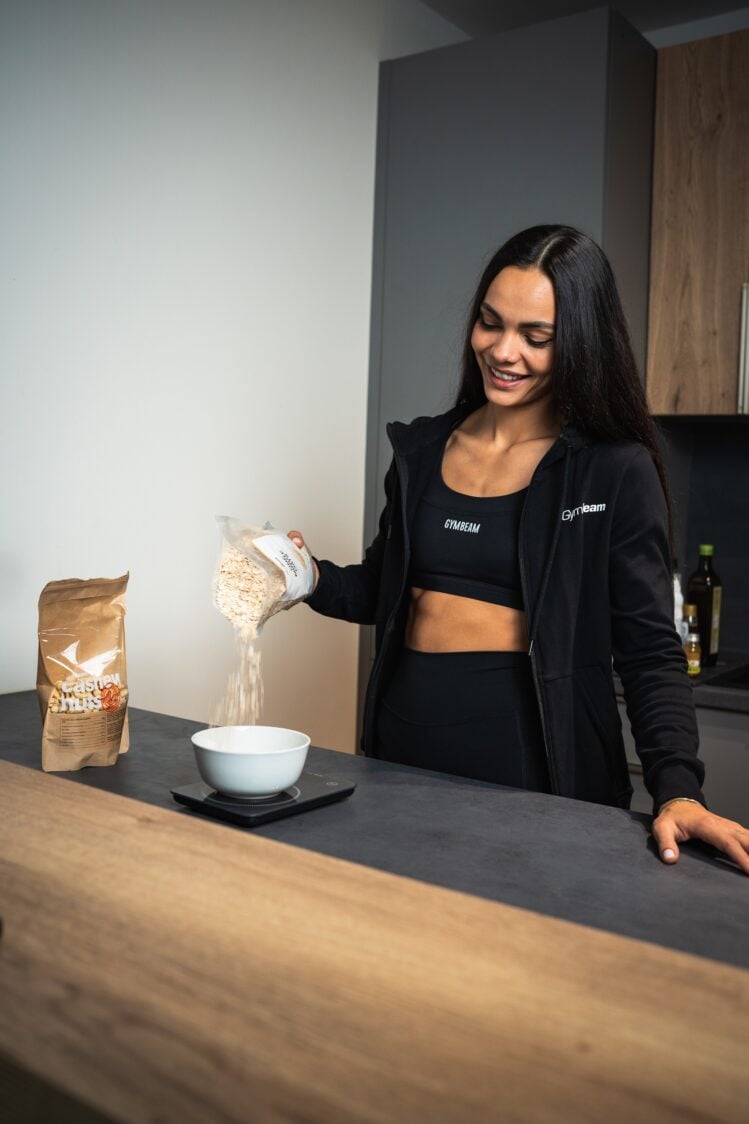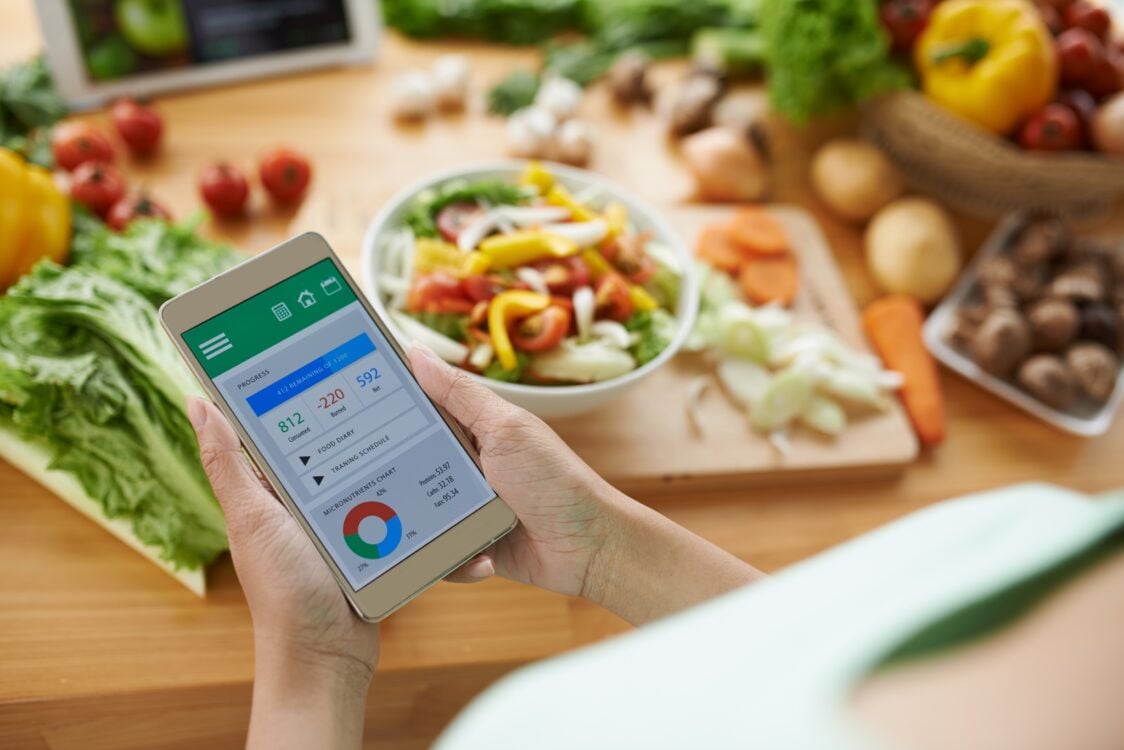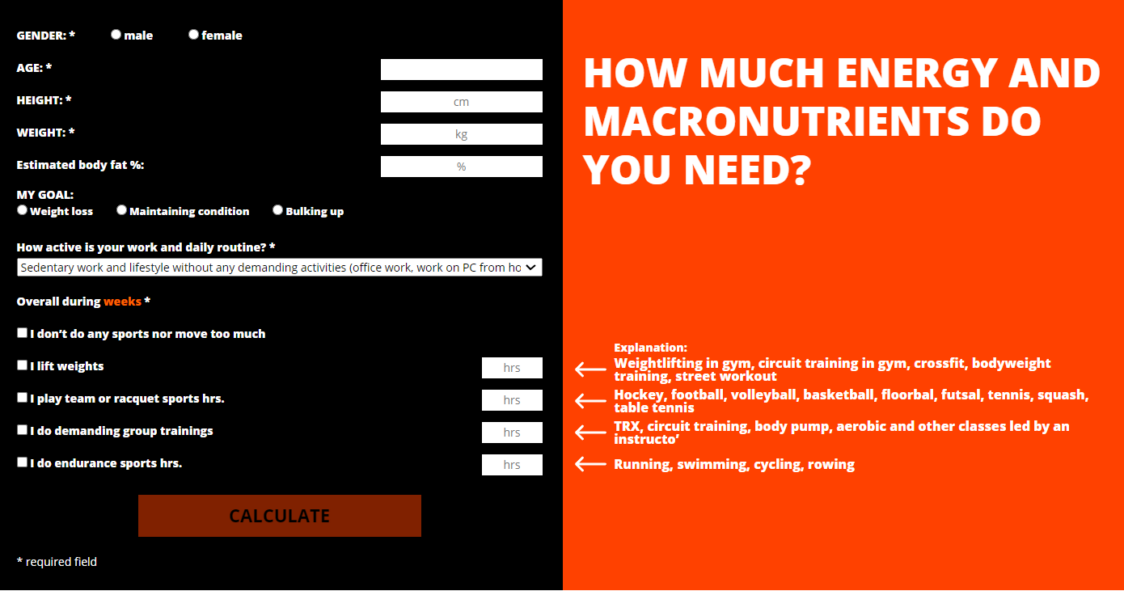Table of Contents
Whether your goal is weight loss, muscle growth, or maintaining fitness, a properly crafted meal plan is a key factor for success. The first step is optimizing your calorie and macro intake. You wouldn’t want to feel hungry during a diet or excessively full while gaining muscle. Finding the right balance of energy intake and macros that’s sustainable for you in the long run is crucial and will yield results. You can determine it through various equations or use online tools, such as our online calculator.
But what do you do once you know how much energy and individual macros you should be consuming? This article will help you with creating a personalised meal plan based on the calculated data.
In the article, we’ll break down the following steps of meal planning:
Is a meal plan based on calorie and macro calculations suitable for everyone?
An energy and macro calculation tool calculates how much you should eat based on your goal, sports activity, physical parameters, and lifestyle. It operates on precise calculations but lacks information about your dietary history, genetics, and hormonal health, which also impact weight loss or muscle gain.
Someone might have adapted metabolism to lower energy intake after years of strict dieting, often referred to as a slowed metabolism. In such cases, the calculated macros may not align with the results you’ve expected. Therefore, it’s crucial to consider the resulting macros from the calculator only as a starting point. If they aren’t producing results, a bit of tweaking, gradual adjustments, and experimentation are going to be necessary to find what works for you. If progress is still elusive, seeking the guidance of a nutritionist or other nutrition professional is the best course of action. [1]
Whether your goal is weight loss or muscle gain, remember that diet isn’t the sole influencer of your results. Exercise, genetic makeup, hormonal environment, sleep quality, and stress management all play significant roles. Also, bear in mind that adhering to a new meal plan is a long-term commitment, and quick expectations like losing 10 kg in 10 days are unrealistic. Everything takes time and patience, especially if you’re aiming for lasting, sustainable results.
- If you’re getting into weight loss and want to know what to be cautious about and potential pitfalls to avoid, read the article 10 Things You Must Know Before Starting to Lose Weight.
- If you’re striving to build muscle mass, don’t miss the article 10 Nutritional Tips for Maximum Muscle Growth.

11 Steps to Build a Custom Meal Plan Using a Calorie Calculator
For a better understanding of each step, let’s walk through a specific example of Mia, who aims to lose 10 kg and tone her body. Mia is a 31-year-old math teacher at a primary school. A few months ago, she started playing squash once a week with a friend and working out at the gym twice a week, focusing on full-body training. While she did manage to shed 3 kg through exercise, her weight has plateaued for the past few weeks. Consequently, she decided to make some adjustments to her diet.
1. Weigh Yourself and Take Your Body Measurements
Before making any changes to your meal plan, record your starting position. Weigh yourself in the morning on an empty stomach with just your underwear on and measure your waist and hip circumference. If you want, you can track measurements for other body parts, such as arms, abdomen, thighs, or calves. You may also take pictures from the front and side in well-lit conditions.
For more precise results, consider using an InBody device for a detailed analysis of your body composition. This will provide insights into your total body fat and muscle mass. If you prefer a DIY approach, you can try measuring body fat using calipers.
Mia’s current measurements:
- Height: 173 cm
- Weight: 80 kg
- Waist circumference: 81 cm
- Hip circumference: 106 cm
- Body fat percentage (measured on InBody): 30
You might be interested in these products:
2. Calculate Your Energy and Macronutrient Intake According to Your Goal
Enter all necessary information into the calculator. The more accurate data you provide, the more reliable the results will be. In addition to age, height, and body weight, include details about your lifestyle’s demands and weekly physical activity. If you know your body fat percentage, inputting it will enhance the accuracy of the final result.
Entering Input Information into the Calculator
- Mia’s goal is weight reduction, so she chose the weight loss option from the three provided (weight loss, maintaining good condition and weight, or gaining weight).
- She works as a teacher, which corresponds to a slightly active occupation.
- She engages in strength training for a total of 2.5 hours and plays racket sports for 1 hour per week.
- Result: 2,240 kcal/day, 284 g of carbohydrates (C), 136 g of protein (P), 62 g of fat (F)
If you want to delve deeper into the intricacies of appropriate energy and macronutrient intake, read our article on How to Calculate Energy and Macronutrient Intake for Weight Loss or Muscle Gain. This will provide a clearer understanding of the calculation process, making it easier to work with the online calculator results.
What individual energy and macronutrient intake recommendations did Mia receive?
Grams per Day | Percentage Breakdown | Energy Value | |
|---|---|---|---|
| Protein | 136 g* | 24.3 % | 544 kcal |
| Carbohydrates | 284 g | 50.7 % | 1,136 kcal |
| Fat | 62 g | 25 % | 558 kcal |
| Calories | 2,240 kcal |
* This value corresponds to 1.7 g per kg of body weight. It represents a higher protein intake necessary for muscle recovery after strength training. Simultaneously, it supports the maintenance of muscle mass during weight loss, protecting muscles from being used as an energy source and inducing a higher feeling of satiety.
If you want to learn more about why protein is important for weight loss, muscle building, or sports performance, read the article How Much Protein to Eat for Muscle Growth, Weight Loss, Endurance Support, or During Pregnancy?

3. Create a Basic Meal Plan Outline
First, consider your eating habits. Answer these questions:
- How many times a day do you prefer to eat? Consider your daily routine, including exercise and other activities. When do you have time for meals? Are you accustomed to snacking, or do you prefer three large meals a day? Ultimately, the number of meals is not decisive; it’s the overall energy intake per day that matters.
- Does it suit you to have approximately the same amount of food for breakfast, lunch, and dinner, or do you prefer, for example, a larger lunch and a smaller dinner?
Percentage distribution of daily intake based on the number of meals
After answering these questions, write down all daily meals (breakfast, snack, lunch…) on paper. Assign a percentage to each meal, indicating the portion it represents of your total daily intake. Divide your 100% throughout the day based on the size of the meal that suits you at that time. This approach will make it easier for you to calculate how many calories you should approximately consume in each meal. You can find inspiration for the percentage breakdown of energy into 3–6 meals in the table below.
How to distribute your daily energy intake throughout the day?
Breakfast | Lunch | |||||
|---|---|---|---|---|---|---|
| 3 meals | 33 % | – | 33 % | – | 33 % | – |
| 4 meals | 25 % | – | 30 % | 15 % | 30 % | – |
| 5 meals | 25 % (560 kcal, 71 g C, 34 g P, 15.5 g F) | 10 % (224 kcal, 28.4 g C, 13.6 g P, 6.2 g F) | 25 % (672 kcal, 85.2 g C, 40.8 g P, 18.6 g F) | 15 % (336 kcal, 42.3 g C, 20.4 g P, 9.3 g F) | 25 % (560 kcal, 71 g C, 34 g P, 15.5 g F) | – |
| 6 meals | 25 % | 10 % | 25 % | 10 % | 25 % | 5 % |
For Mia, eating five times a day, with a slightly larger afternoon snack, works well. We calculated the energy and macronutrient values for each meal in parentheses. Mia now has values to guide her when planning individual meals.
Now, take your numbers from the calculator and calculate your values for each meal. For clarity, it’s best to create a similar table with your calculated data.
For example, to calculate 25% of the total daily intake of 2,240 kcal, 284 g C, 136 g P, 62 g F, you can do it as follows:
- Calories: 0.25 × 2,240 kcal = 560 kcal
- Carbohydrates: 0.25 × 284 g = 71 g
- Protein: 0.25 × 136 g = 34 g
- Fat: 0.25 × 62 g = 15.5 g

4. Plan Specific Meals
Now that you and Mia have calculated values for each meal, take a break from mathematics and move on to the enjoyable part – meal planning. First, take a pencil and paper, and write down meals for one day. Opt for simple dishes with a minimal number of ingredients to make it easier to enter them into the app later. You can simplify your routine by alternating only a few main meals and snacks during the week. Don’t stress about creating creative dishes for every day initially. Break down your meals into individual ingredients, similar to the table below. Be careful not to forget any calorie-contributing ingredients, such as oil or salad dressing.
At the beginning, you could benefit from writing everything down on a piece of paper rather then inputting everything just into the app. At the same time, you can create a shopping list according to this schedule.
When planning meals, keep in mind the rules of a healthy diet. It’s essential for each meal to include high-quality sources of macronutrients. However, also consider your goal when choosing foods. If you’re trying to gain weight, you can include higher-fat meats and dairy products in your energy intake. If, on the other hand, you’re losing weight, opt for less calorie-dense sources that provide necessary proteins without significantly increasing energy intake.
- Sources of Protein: Meat, fish, seafood, milk and dairy products, eggs, legumes (peas, beans, lentils, chickpeas, edamame), tofu, tempeh, seitan, whey protein, plant-based protein.
- Sources of Fat: oils, butter, plant-based spreads, nuts and seeds, nut butters, olives, avocados, high-percentage dark chocolate.
- Sources of Carbohydrates: whole grains and cereals (oats, flour, rice, pasta, bulgur, quinoa, buckwheat, porridge), bread, rice cakes, tortillas, potatoes and sweet potatoes, legumes, honey, syrups, xylitol, and other sugar alternatives, fruits, and vegetables.
You can also find inspiration for creating a meal plan in the article Sample Meal Plan and Box Diet for 2,000 kcal.
Mia has planned the following meals:
| Breakfast | Protein Oatmeal with Peanut Butter and Banana | Whey protein, oats, peanut butter, banana |
| Morning Snack | Greek Yogurt with Apple and Nuts | Greek yogurt, apple, cashews |
| Lunch | Rice with Baked Chicken and Vegetable Salad | Basmati rice, chicken breast, olive oil, zucchini, bell pepper, tomatoes, onion |
| Afternoon Snack | Rye Bread with Butter, Turkey Ham, and Cucumber | Rye bread, butter, turkey ham, cucumber |
| Dinner | Tortilla with Tofu, Vegetables, and Yoghurt Dressing | Wheat tortilla, marinated tofu, plain yoghurt, olive oil, lettuce, bell pepper |
5. Plan Your First Day in an App
Now it’s time to use a meal tracking app such as MyFitnessPal, Lose It!, or Calorie Counter. Transfer your planned meal schedule from paper to the app. If you haven’t used these apps before, it might take a bit of time to get used to, but you’ll quickly learn how to navigate them, and data entry will become more efficient.
- Create your account in the app, and after entering your goals, height, and weight, adjust the recommended intake values to match those you obtained from the online calorie calculator. For example, Mia will enter 2,240 kcal, 284 g C, 136 g P, 62 g F.
- If you’ve never weighed your food and have no idea how many grams are in your typical serving of side dishes, bread, meat, or peanut butter, try weighing all foods (ideally in raw form) for at least two days. Record everything in the app. Eat normally during these two days without worrying about whether your calorie and macronutrient intake aligns with your target values. This will give you a rough idea of your typical portion sizes and your current calorie intake.
- Now, try planning a one-day meal schedule to fit the calorie and macronutrient intake you calculated with the online calculator and already entered into the app. Thanks to this, you will know in advance how many grams of oatmeal you should have for breakfast and all other foods for the day. Refer to the list of meals and ingredients you outlined in step 4.
- Open the first day and add the ingredients, including quantities (in raw form). You won’t know right away how many grams of a particular food to add to match your values for the entire day. You’ll need to experiment with different amounts to get your intake right.
- Once you have the entire day entered, check the app for your daily intake of energy, proteins, carbohydrates, and fats. If it significantly deviates from your goals, don’t worry. It’s challenging for beginners to get it right on the first attempt.
- Open the entire day again and check the calories, proteins, carbs, and fats for each meal. Compare these values with the planned ones you calculated based on percentages in step 4. For example, if you notice you have too many carbs for the day, identify the meal where you’ve exceeded the limit and reduce the amount of the carbohydrate-rich food. Sometimes, you might need to exchange one ingredient for another that fits better into your daily intake. Similarly, you may need to add or reduce another food item.
- You don’t have to hit the exact macro targets for every meal you calculated. In the end, it’s crucial that your overall daily energy intake is roughly within a 10% deviation.

Mia needs to get closer to these values:
- Breakfast: 560 kcal, 71 g C, 34 g P, 15,5 g F
- Morning Snack: 224 kcal, 28.4 g C, 13.6 g P, 6.2 g F
- Lunch: 560 kcal, 71 g C, 34 g P, 15.5 g F
- Afternoon Snack: 336 kcal, 42.3 g C, 20.4 g P, 9.3 g F
- Dinner: 560 kcal, 71 g C, 34 g P, 15.5 g F
Learn more about what to watch out for when counting calories and macronutrients in apps in our article 10 Common Mistakes When Counting and Logging Calories in Apps.
Whole Day Meal Plan with Weight in Grams
Energy and Macronutrient Content | ||
|---|---|---|
| Breakfast | Whey protein 25 g Oats 60 g Peanut butter 20 g Banana 120 g | 569 kcal, 71 g C, 33.8 g P, 15.5 g F |
| Morning Snack | 0% Fat Greek Yoghurt 140 g Apple 150 g Cashews 15 g | 268 kcal, 17 g P, 24 g C, 8 g F |
| Lunch | Basmati rice 70 g Chicken breast 150 g Olive oil 15 g Zucchini 100 g Sweet Pepper 50 g Tomatoes 50 g Onion 20 g | 568 kcal, 63 g C, 40 g P, 14 g F |
| Afternoon Snack | Rye bread 90 g Gervais cheese 20 g Turkey ham 60 g Cucumber 100 g | 335 kcal, 45 g C, 21 g P, 6 g F |
| Dinner | Wheat tortilla 90 g Marinated tofu 100 g Plain yoghurt 50 g Olive oil 10 ml Lettuce 50 g Sweet Pepper 100 g | 567 kcal, 56 g C, 24 g P, 24 g F |
| Total Intake | 2,260 kcal, 266 g C, 138.2 g P, 66.3 g F |
6. Continue Logging Upcoming Days
Once you’ve successfully planned the first day, you can move on to the next one. If you know that some meals will be partially or entirely repeated, copy them directly within the app for the next day. Sometimes, it will be sufficient to swap a few ingredients, and you’re done.
Over time, you’ll likely notice that some foods have very similar nutritional values, and you can swap them around as needed. This applies, for example, to various oils (olive oil, rapeseed oil, avocado oil), grains (rice, bulgur, couscous), or bread (rye or whole wheat bread). It’s also a smart move to save favourite meals that you frequently repeat. For example, if you regularly have the same protein oatmeal, save it as a complete meal in the app and then enter it as a whole. [2, 5]

7. Prepare Planned Meals in Advance
Once you have your meals planned and groceries purchased for the upcoming days, there’s nothing left but to take out the kitchen scale and start cooking. While you can prepare your meals on the same day, there might be times when you don’t have the time or energy to cook. In such cases, you might reach for convenience foods that might not fit well into your nutritional goals.
Keep in mind that pre-prepared meals are 50% of success. Take advantage of repeating meals in your plan. Cook larger portions at once and proportionally divide the food into containers.
If during the day you crave something different, simply swap the dish in the app and adjust other meals if necessary to roughly match your overall energy intake.
For more tips on meal prepping and box meals, check out the article How to Efficiently Prepare Meals and Use the Container Method?
8. Don’t Strive for Perfection
Approach the overall adjustment of your meal plan with the understanding that not every day will be perfectly aligned to the gram or calorie. A perfect meal plan doesn’t exist, especially considering that nutritional values in apps may not always be accurate. Over time, you’ll also realize that you can allow yourself a certain level of flexibility.
If you decide to have a larger afternoon snack than planned, you can compensate by reducing the portion size of your dinner, and you’ll still fit comfortably into your daily values. If you occasionally exceed your target values, that’s okay too. For most people, consistently following the plan at 80-90% is usually sufficient, and results will still come. Consistency is more important than perfection. [3]
Your meal composition doesn’t have to look like it’s from a healthy eating magazine either. Occasionally plan for a favorite dessert or savory treat instead of a snack. If you manage to adjust the rest of your meal plan to meet your macronutrient goals for the day, you’re on the right track. For those who are bulking or have a generally higher energy intake, there’s a bit more room for such foods. Still, stick to the 80/20 rule, where 80% of your diet consists of basic, minimally processed foods and 20% includes sweets, chips, fast food, pizza, and other indulgences.
If you’re interested in which foods to be cautious about when planning your meal schedule, read the article 7 Tips on How to Limit Highly Processed Foods and Eat Healthier.
Discover our bestsellers:
9. Conduct a Check-in Measurement and Adjust the Meal Plan as Needed
After two weeks of following your meal plan, it’s time for the first check-in measurement and evaluation of how your new eating regimen suits you. Weigh yourself again, measure your body dimensions, and take photos under the same conditions as during the initial measurement.
Mia’s Check-in Results:
- Height: 173 cm
- Weight: 79 kg
- Waist circumference: 80 cm
- Hip circumference: 105 cm
After two weeks, Mia lost 1 kg, which corresponds to a healthy weight loss rate of 0.5 kg per week. She feels good on her meal plan, but sometimes she would prefer slightly smaller carbohydrate portions. Therefore, she decided to reduce her intake by 250 kcal, focusing on carbohydrates, for the next two weeks. She will then evaluate her progress again.
For you, it’s also possible to make minor adjustments to your meal plan. While significant changes might not be expected after two weeks, you might see some changes in your body measurements. However, be cautious not to make drastic changes.
How to Adjust Your Meal Plan?
- If your goal is weight loss but you haven’t seen changes in kilograms or centimetres yet, try reducing your energy intake by 250 kcal.
- In the case of aiming to gain body weight and not observing any changes, you can try adding 250 kcal.
You can subtract/add these 250 kcal evenly across all nutrients or play with their ratio. However, keep the protein intake the same. You can increase or decrease the content of carbohydrates or fats.
And how to convert 250 kcal into grams of fats or carbohydrates? Just know that 1 g of carbohydrates (and proteins) has an energy value of approximately 4 kcal, while 1 g of fats is about 9 kcal.
- 250 kcal = 62.5 g carbohydrates
- 250 kcal = 27.8 g fat
When planning your meal plan in the app, you can play with numbers as well. For example, try increasing the fat intake by a few grams and decreasing carbohydrates, or vice versa. Over time, you can figure out the macronutrient ratio that suits you best. Still, remember to end the day with the same total energy intake. After adjusting the meal plan, weigh and measure yourself again after another 2-3 weeks. [4]
If your weight still doesn’t change, another factor may be influencing it. You can learn about various factors that can cause weight fluctuations in the article Why your Scale Shows a Higher Number, and It’s Not Fat.

10. Utilize Artificial Intelligence (AI)
Have you already acquainted yourself with chatGPT or another AI tool? If yes, it probably won’t surprise you that it can help you with your meal plan. When you need inspiration for new meals, simply type into the chat box that you need advice on preparing a healthy dish, perhaps with chicken, zucchini, tomatoes, and other ingredients of your choice. In no time, you’ll get dozens of recipes to try.
You can also ask for a list of fitness recipes for weight loss or foods high in protein. There are many possibilities to leverage artificial intelligence in this regard. Feel free to use it for calculations, but be cautious to make your query always clear and as specific as possible.

11. Don’t Always Be on a Diet
Weight loss and healthy weight gain are long-term journeys with goals that are often not immediately visible. It’s essential to realize that at some point, you’ll have to leave that path and stop racing, especially in the case of weight loss; staying in a caloric deficit for, let’s say, a year is not a good idea. It can negatively affect metabolism and hormonal health. Therefore, after a few months, set a maintenance intake, which you can also calculate using our online calculator, or you’ll know it over time through self-monitoring. And if you want further progress, you can reintroduce a diet after a few months.
It’s also not a bad idea to occasionally put away the kitchen scale and calorie-counting app for a day or two and free yourself from all those numbers. This way, you’ll remember that food is not just about calories and macros but also about taste, aroma, and sharing moments of joy with your loved ones.
What should you remember?
Thanks to today’s article, you’ve learned how to create a meal plan for weight loss, weight gain, or maintaining good condition based on values from an online calculator. When you manage to adapt it not only to your goals but also to your dietary preferences, you’ve succeeded. However, the best results are achieved through a comprehensive approach, including regular exercise, sufficient rest, and quality sleep.
If you liked the article and found it practical, share it with your friends. They will surely appreciate tips on creating a personalized meal plan.
[1] National Academies Press (US). Factors That Influence Body Weight. – https://www.ncbi.nlm.nih.gov/books/NBK221834/
[2] Macro Meal Planner: How to Portion Foods to Fit Your Macros. – https://www.trifectanutrition.com/blog/macro-meal-planner-how-to-portion-foods-to-fit-your-macros
[3] Romans, C. The Pros and Cons of Using Calorie Counting Apps. – https://www.makeuseof.com/pros-cons-using-calorie-counting-apps/
[4] EverydayHealth.Com. How to Count Macros: A Detailed Beginner’s Guide. – https://www.everydayhealth.com/diet-nutrition/how-to-count-macros-a-detailed-beginners-guide/
[5] Precision Nutrition. How to Count (and Track) Macros for Fat Loss, Muscle Gain, and Better Health. – https://www.precisionnutrition.com/how-to-count-macros



Add a comment